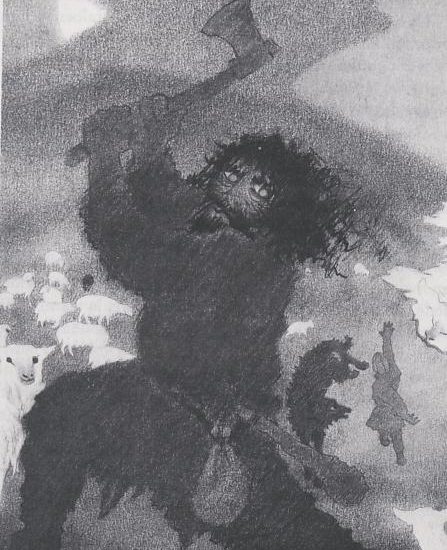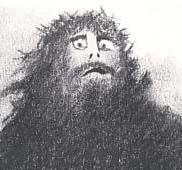STÁLLO AT CHRISTMAS

 You are Reading..
You are Reading..
STÁLLO AT CHRISTMAS
This is an interview from 1973 with Nils Jernsletten done by Dag Skogheim, a Norwegian researching about Sami culture and mythologi. This text is transcribed directly from the interview and freely translated to English, and may not be 100% accurate. The whole interview is not included here.
Dag: Yes, Jernsletten. The concept of “stállo” in Sami….
Nils: Yes, stállo it is a figure that we can say is specifically Sami, although the name stállo probably comes from the Nordic “Ståle “or “Stali”, it has got its own place among Sami legends.
Stállo was a big guy, much bigger than ordinary people and much bigger than a Sami.
He was usually dressed differently than Sami, ie in dark clothes, he also had gold buttons and wore a sack.
He also had a pipe, a whistle that the Sami could occasionally hear him blowing on.
The whistle tone was so sharp that it could be dangerous for the ears.
Dag: He is no similar to trolls then?
Nils: No, they are not trolls.
As I have understood trolls, trolls are a supernatural figure who live in the mountains and such.
I perceive stállo much more concrete. Though it could probably have supernatural abilities too …
By the way, there were several kinds of stállo which I think is a mixture of “gand” and stállo. That the Sami themselves, the noaidi (the Sami shaman) could make stállo and send on others …
Dag: Yes it is important to say ..
Nils: Yes, and they could also be dressed in Sami clothes.
The noaidi people could fight with each other by sending stállo on others. And in turn – the others, if they had noaidi, could also send stállo back at them.
Such tales also exist.
Day:So it’s actually magic to some extent?
Nils: Yes, but the figure stállo itself in most tales is not magic. It is a giant figure that the Sami could often encounter, and which one had to be careful with.
I remember from when I was a child that we were scared a little with stállo in Christmas time. Then we should not make too much noise, because then stállo could come.
And then you could hear his whistling.. Or he could simply come. And if you did not get away then it was dangerous for the kids.
There are many tales where stállo takes .. For example a legend where stállo enters a Sami camp when the kids are out making noise on Christmas day- and they should not be.
And then stállo comes, and when the kids see him they run into the goahti and hide. Some hide under the branches and some inside the box and behind the backpack and so on.
But if the stállo gets hold of some of them, he takes them out and slaughters these kids and he also spreads their intestines around.
It’s pretty grotesque.

Dag: I immediately think of our (the Norwegian) Åsgårdsreia tales.
Because it’s the same horror. We know that it’s a combination of the dead evil spirits that are at Christmas time, and they take people.
They kill them.
It’s really death coming as guests.
Is there any connection like that, do you think? Between the two cultures, that one has mutually influenced the other.
Nils: It may well be the case that different elements have influenced each other. The Sami have always had contact with Norwegians as well.
Not only the southern Sami, but also far north.
Such different elements of folklore have probably mixed together.
And recent things that indicate that, for example, Sami shamanism and the Norse shamanism have certain connections to each other.
But stállo also had other sides. He was rich, had silverware. Was rich in silver and gold.
That he has in common with trolls.
But I can also imagine that there are certain….
Some of the background for that may also be the tax collectors. Those who went on tax collection, and robbed occasionally. Often the high-ranking soldiers were dressed in the same way as stállo.
Dag: Yes, there are clear features that are repeated there.
But do you have trolls in Sami culture, or in oral tradition? Something which corresponds to our specific Norwegian troll that is?
Nils: No. I have learned that we can interpret troll as a kind of natural figure, which has something to do with natural poetry and the longing for natural forces and all that…
Those are other concepts that have nothing to do with stállo.
I will say a little about that, but I will say one more thing about stállo which is important. In these tales he was rich as I said earlier.
If there was a skilled and strong Sami, then they could fight him.
He challenged them and if they fought with the stállo and managed to win over him ….
It was a battle of life and death, so if you did not win you were killed. But if you could win over him…. and you had to stab Stallo to death with your own knife.
When it came to the point where stallo realized he had been defeated, stállo always says that now you have to stab me with my own knife.
But that you shouldn´t do, because it was most dangerous for you.
And then they killed stállo. The Sami killed stállo and then got all the gold and silver that stállo had.
There are inherited silver that have such legends attached to it.
Often the riches that one got from stállo were not long lasting. They disappeared easily.
Dag: Just to get back to what you mentioned at Christmas time, is it specially at Christmas time that stállo is very active? You mentioned at Christmas time that it sounds like an educational measure.
Nils: Yes, it can be. But not that he was particularly active at Christmas time, but it is natural in a way that such scare pedagogy and such life stories where one should scare the children were clearly connected to Christmas.
It’s dark season and so…
But stállo could be met all year round.
But the tales where he came in and killed children were specifically on Christmas.
There were other things also in connection with the stállo legend at Christmas time, that you had to make sure to have order in the house and not have scraps from chopping wood outside. If you chop wood outside, there should be no sawdust left.
Also, one should have water in a bucket standing by the door so that if stállo came in and asked to drink water then there should be a ladle there so he could drink water and then he went out again.
If there was no water then he could make trouble.
Dag: And it’s also Christmas time?
Nils: Yes, it belongs to Christmas.
Dag: Yes, exactly. Now, this here with trolls who …
Nils: Yes, there I have something called háldeaččat.
As you can read from the legends ….
I have not read any kind of folklore research theories about this, but as you read from the tales, as I remember, they are more neutral forces. Natural forces. Háldeaččat. Háldi is the one who protects and takes care of nature and such. For example animals and wildlife and such.
Dag: Oh, it’s kind of protective spirit ?
So you know our “tomte”. “Hustomten”. It’s not really anything other than the forefathers’ spirits.
The one who made sure that the people kept the house well.
Is there such a thing just that it is transmitted to nature?
Nils: Yes, it can probably be something like that, because you know that the old Sami society it was … The basis of life for it was fishing and hunting and so on.
So that it is natural …
Dag: Excuse me for interrupting, but are these phenomena you are now referring to one or more?
Nils: There are several, because they belong to nature and live in different places. There are also mountains called háldi.
Dag: Yes, so then you can say that these are related to the expressions of life in nature.
Nils: You could say that.
Day: And they do not represent any fear or horror on human beings?
Nils: No, they do not. If you behaved sensibly out in nature, there was usually no danger.
I remember many such stories that put a little shock in me as a child.
People who were hunting and such, they could often meet and hear such háldeaččat.
That they came to visit the person in the goahti.
Day: So hearing impression then?
Nils: Yes, it was a kind of revenge then if you deserved revenge.
That they started harassing one and started putting out the fire and knock over pots and stuff.
Dag: So if you commit some violence on nature or nature’s expressions of life, then this will happen…
You can find the interview in Norwegian here: https://gammel.nfk.no/arkivinordland/arkivmateriale/samlinger/nettutstillinger-og-artikler/nils-jernsletten-om-stallo.74963.aspx
Read about Åsgårdsreia in Norwegian here: https://sverresborg.no/juletradisjoner

I found out I am Sami when I took a DNA test. I have taken two different tests now. It is my mother’s bloodline. Since then I have been trying to find out all I can about my ancestry. I love reading the posts on here.
So nice to hear that! Thank you so much!<3
warm regards Elin & Jungle.